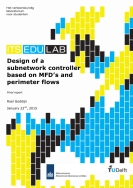The traffic state of a road network can be described by a so called macroscopic fundamental diagram (MFD). In this diagram the average production is related to the accumulation of traffic in a specific road network. A promising application field of the MFD is to introduce the MFD in the algorithm of a traffic controller. Due to increasing congestion on urban roads, extra road capacity might be needed. However, for economic reasons better usage of the current road capacity is preferred. Therewith, the intersection density in road networks has increased nowadays. One of the consequences is that the way of controlling a certain intersection influences the traffic state at another intersection. Therefore, traffic controllers should be connected when controlling traffic at individual intersections. In this thesis a subnetwork flow controller has been designed.
A road network which is controlled in a hierarchical setting by a main controller can be split up in several subnetworks. By controlling the perimeter flows between the subnetworks, the traffic state of each subnetwork can be controlled. In this thesis, only traffic signals at intersections have been taken into account as the control units. The designed subnetwork flow controller had to contribute to three main objectives: 1. Maintaining a constant shaped MFD, 2. Optimizing internal flows, and 3. Provide desirable perimeter flows. The subnetwork flow controller algorithm has been based upon a back pressure algorithm which belongs to the coordinated traffic responsive control strategies in existing traffic controllers. A back pressure algorithm has been chosen due to the property of balancing queues which should result in homogeneity of traffic conditions within a subnetwork. The back pressure algorithm determines pressures for every individual intersection and every traffic phase consisting of several traffic streams. In order to evaluate the performance of the designed subnetwork flow controller, simulations have been performed in VISSIM where the subnetwork flow controller has been applied. Simulations have been performed with subnetworks consisting of four, eight and sixteen intersections and different applied demand patterns.
It turned out that a subnetwork consisting of sixteen intersections controlled by a vehicle-actuated controller or back pressure controller provides a MFD with the lowest scatter size, determined by the standard deviation of the absolute scatter deviation with respect to the constructed running median of the MFD. This low scatter resulted also in a constant shape of the MFD independent of the applied demand pattern. Therewith, with increasing size of the subnetwork the back pressure controller was able to control the traffic in the subnetwork better when evaluating total delay and internal production. This is caused by the result that gridlocks can be postponed by the back pressure controller. When applying the designed subnetwork flow controller on a subnetwork consisting of sixteen intersections, it turned out that there was no significant difference in performance on all three objectives between the applied deviation factors. The subnetwork flow controller designed in this thesis has been proven to work properly according to the simulation results. When the subnetwork flow controller provides the desired perimeter flows (under certain circumstances), a constant shaped MFD can be maintained. However, another result is an increase in delay and thus less optimal internal flows compared to the performance of a vehicle-actuated controller.
